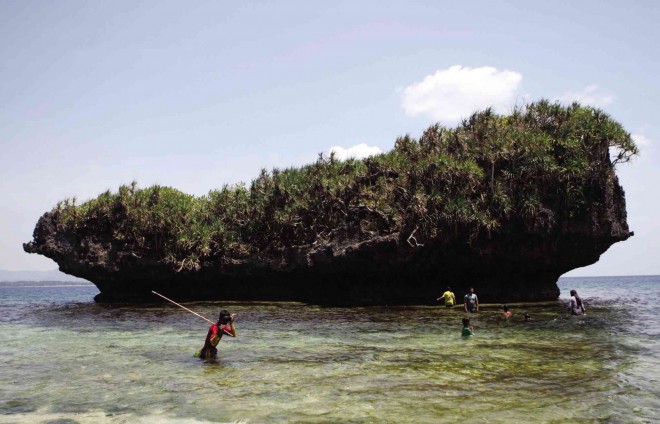Laid-back in Lubang

VISITORS and a local diver look for fish around a rock islet considered the symbol of Cabra Island. INQSnap this page (not just the logo) to view more photos. LYN RILLON
Beyond the mountains where a Japanese straggler hid for 30 years after World War II, white sand beaches, coral islets and underwater wonders beckon to the weary soul.
The shores of the 125-square-kilometer Lubang Island in Occidental Mindoro province start just a few steps from the town center. A couple may sit, talk or simply stare at the sunset in silence as egrets peer for prey on a sandbar a few meters away.
On a clear day, an early-morning cruise along the coastline is a feast to the eyes. Varied rock formations greet visitors on their way to Hulagaan Beach. Visible in the crystal-clear waters are corals growing anew.
Once, illegal fishers, possibly outsiders, lurked in the waters around Lubang, says local fisheries officer Michael Dennis Mendoza, 28. The islanders are basically farmers who fish only for family consumption, he adds.
Mendoza’s office has been strictly enforcing marine laws around Lubang since the island group was declared a marine protected area recently. Bantay Dagat volunteers have been catching and prosecuting fewer culprits these days, Mendoza says.
Beach, falls
Hulagaan Beach can be reached in 30 minutes by a motorized outrigger boat from the shore of Barangay (village) Tumimbo, a 45-minute drive from the town center.
“The water here is alkaline,” Mendoza says. He picks up a discarded plastic bottle as he sets foot on the beach smothered by stones (batong buhay) that no one can take home. Plastic has been a bane to the fish these days, as they eat more of it than plankton these days.
Spinner and bottle-nosed dolphins and the endangered wrasses are seen in the area, Mendoza says. Once, he and his men rescued a sick whale and took care of the creature for three weeks, but it eventually died.
Olive ridley, loggerhead, hawksbill and green turtles nest on the shores this time of the year.
About 30 minutes upstream of the beach is Hulagaan Falls, which can be reached by hiking on two paths—Cardiac Trail, a steep but shorter route, and the gradual sloping but longer route. Both are under a canopy of forest trees, which also provides protection for wildlife like vipers.
A rest house of wood and stones is just a few meters from the beach and nearby, a toilet similarly built. Campers and visitors can stay here overnight, Mendoza says.
Cabra Island
From Hulagaan, it takes about an hour of cruising westward to reach Cabra Island, which is said to have been formed from a huge coral reef.
Apparitions of Our Lady of Immaculate Conception had been reported there from 1966 to the 1970s, making the island a pilgrimage site for Marian devotees. A chapel has been built near the places of the apparitions.
Cabra has another pristine beach that faces a rock jutting out like a miniature of the island. Residents regard the rock as the village’s symbol because it is shaped like a cabra or goat. Swimming is ideal during low tide around noon.
A lighthouse built in 1889 during the Spanish period is now rickety and closed to visitors. Beside it is another lighthouse put up by the Department of Transportation and Communications, which uses solar power.
Fishermen can be seen catching octopuses, wrasses and talakitok (trevally).
Community tourism
The local government is developing other areas, such as Binacas Picnic Grove, especially for snorkeling. A mariculture park, where corals are grown, is already in place, along with mangrove plantations.
In 2011, Lubang and Looc towns produced a tourism master plan that envisions the development of community tourism on the islands. Many of its provisions are already in place, while others await funding for implementation.
Since facilities for tourists are limited to a few inns, the Lubang municipal government is encouraging residents to go into homestays. Big empty houses along the main road and owned by natives who have gone abroad to work, can be converted into bed-and-breakfast inns, says Gina Julaton, tourism officer.
Souvenir shops are nowhere to be found. All vehicles are rented.
“We need to introduce Lubang so investors will come, and especially for natives to return …. This is our priority,” Julaton says.
But Lubang is not in a hurry to jump into the tourism bandwagon. Local officials do not want a kind of tourism that destroys the environment and kills the moral fiber of its residents.
“We have zero crime rate here,” Vice Mayor Carlos Villas says. “No matter how beautiful the place is, if there is no peace and order, it is useless.”
RELATED STORY














